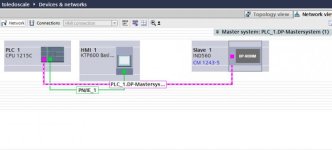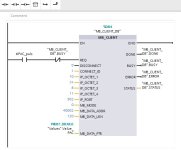Hi all,
I've been given a system to design containing a whole lot of things I haven't worked with much (or at all) before. My PLC is a Siemens S7-1200, my HMI is a Siemens KTP600 Basic Panel with Profinet interface, and I have to communicate with a Mettler-Toledo weight controller, which speaks Profibus or Modbus TCP, but not Profinet. So far my plan of attack looks like this:
Plan A is to have the S7-1200 talk Modbus TCP to the Mettler and Profinet to the HMI from the same port at the same time. Is this possible? If not...
Plan B is to talk Modbus TCP to both the Mettler and the HMI. Is this possible/straightforward/a pain in the backside?
Plan C is to get a profibus card for the S7-1200 to talk to the Mettler. Does the S7-1200 have such a card, and is it painful to set up?
In any case, I have no experience with Modbus TCP, and the only two things I know about profibus is that the cables are purple and that if you don't do the grounding properly You Are Going To Have A Bad Time. I have a little experience with Modbus Plus, from a few years back, but that's about it. So any advice or tips and tricks on getting it working are much appreciated!
I've been given a system to design containing a whole lot of things I haven't worked with much (or at all) before. My PLC is a Siemens S7-1200, my HMI is a Siemens KTP600 Basic Panel with Profinet interface, and I have to communicate with a Mettler-Toledo weight controller, which speaks Profibus or Modbus TCP, but not Profinet. So far my plan of attack looks like this:
Plan A is to have the S7-1200 talk Modbus TCP to the Mettler and Profinet to the HMI from the same port at the same time. Is this possible? If not...
Plan B is to talk Modbus TCP to both the Mettler and the HMI. Is this possible/straightforward/a pain in the backside?
Plan C is to get a profibus card for the S7-1200 to talk to the Mettler. Does the S7-1200 have such a card, and is it painful to set up?
In any case, I have no experience with Modbus TCP, and the only two things I know about profibus is that the cables are purple and that if you don't do the grounding properly You Are Going To Have A Bad Time. I have a little experience with Modbus Plus, from a few years back, but that's about it. So any advice or tips and tricks on getting it working are much appreciated!








